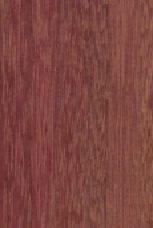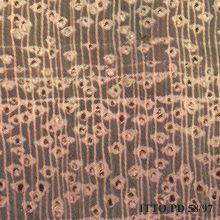
AMARANTE (Peltogyne porphyrocardia)
Trade Name
Amarante
Scientific Name
Peltogyne porphyrocardia Griseb. ex Benth.
Family
LEGUMINOSAE
Common Names
Violet wood; Sapatere; Sapater; Sacka; Rajado; Pao violeta; Marado; Malako; Lastan; Kuruburelli; Kuraburelli; Kouburelli; Koroborelli; Kooroobovelli; Kooroobooelli; Guarabu; Ellongrypho; Dastan; Bois violet; Bois puurpre; Barabu; Violeta (Brazil); Palo Concha (Bolivia); Morado (Bolivia); Bois Pourpre; Violetwood; Tananeo; Sakavalli; Saka; Purperhart; Palo Morado; Pau Roxo (Brazil); Palo Morado; Nazareno (Venezuela); Morado (Venezuela); Koroboreli; Guarab; Amaranth; Amarante; Purpleheart (Guyana); Zapatero (Venezuela)
Description Of The Tree
Botanical Description
It is a dominant tree, it attains heights from 30 to 45 m, with a diameter at breast height between 45 and 90 cm or more. The boles are straight and cylindrical.
Natural Distribution
It is found in the tropical forests of northern South America.
Wood Identification
Anatomic Description Of Wood
Wood diffuse porous. Vessels solitary and in short radial multiples. Tangential diameter of vessel lumina 100 micras or less (very small). Occasionally vessels with colored deposits. Occasionally white deposits in heartwood vessels. Vessels per mm2 more than 2 Axial parenchyma in marginal or in seemingly marginal bands. Paratracheal axial parenchyma scanty and/or vasicentric. Occasionally axial parenchyma storied. Prismatic crystals in chambered axial parenchyma cells and/or in fibers. 3 to 4 cells per parenchyma s 4 to 10 rays per mm (medium). Rays non-storied. Larger rays more than 4 seriate. Homogeneous rays and/or sub-homogeneous rays (all ray cells procumbent). Fibers with simple to minutely bordered pits.
-
 Wood Macro Photo Tangential Plane
Wood Macro Photo Tangential Plane
-
 Wood Micro Photo Of Transversal Section
Wood Micro Photo Of Transversal Section
Availability
Cites Status
Unrestricted
General Wood Description
Odor
It has no distinct odor or taste.
Color
The sapwood and heartwood are clearly differentiated. The heartwood is described as bright purple upon exposure.
COLOR INDEX (1=Black, 7=Light yellow,white)
3
Grain
The grain is typically straight, sometimes interlocked.
Texture
The wood has a medium to fine texture.
Luster
The wood has medium to high luster.
Natural Durability
The heartwood is resistant to decay fungi attack and to termites, but it is less resistant to marine borers.
Natural durability index (1= Very high durability, 7=Vey low durability)
2
Resistance To Impregnation
It is very difficult to treat, but for most applications preservative treatments are not required.
Wood Physical Properties
Basic Density or Specific Gravity (O.D. weight/vol. green) (g/cm³)
0.93
Air-dry Density (Weight and volume at 12%MC) (g/cm³)
1.09
Total shrinkage Tangential (Saturated to 0%MC) (%)
7.7
Total shrinkage Radial (Saturated to 0%MC) (%)
5.0
Drying Defects
Ease of Drying: Drying is rapid. Drying Defects: Moderate cupping and bowing are reported. Casehardening is reported to be severe.
Recommended Dry Kiln Schedule
UK-E; US-T6-D2; JUNAC-A
Dimensional stability ratio (Total Tangential Shrinkage %/Total Radial Shrinkage %)
1.5
Wood Chemical Properties
Wood Mechanical Properties
Bending Strength (MOR),12%MC (kgf/cm²)
2177
Stiffness (MOE) 12%MC (kgf/cm²)
244000
Compression parallel to fiber 12%MC (kgf/cm²)
1020
Shear strength radial 12%MC (kgf/cm²)
171
Janka hardness (side) 12%MC (kgf)
1782
Janka hardness (end grain) 12%MC (kgf)
1593
Workability
Sawing
Peltogyne is reported to be moderately difficult to saw. Tools usually require frequent sharpening.
Rotary Veneer Cutting
This species is interesting for slicing, thermal treatments are recommended.
Sliced Veneer
This species is interesting for slicing, thermal treatments are recommended.
Blunting Effect
Cutting tools may be gummed up if they are not very sharp. Blunting is rated as moderate.
Machining
Peltogyne is reported to be moderately difficult to work in most machining operations including planing, turning, boring, and molding. They respond rather poorly to ordinary tools, and working with dull cutters may cause the wood to heat up.
Planing
A reduction of the cutting angle to 15 degrees is required, when wavy or interlocked material is present, to obtain satisfactory results in planing.
Turning
30
Boring
Boring is difficult, the wood has a tendency to burn
Mortising
To get good results in mortising end support is needed.
Nailing
The wood requires to be pre-bored, but nail-holding capabilities are reported to be good.
Gluing
The material is reported to be easy to glue.
Sanding
The material is reported to be fairly difficult to sand.
Finishing
Organic solvents remove the characteristic purple color. To preserve the natural color, wax finishing is recommended.
Staining
For this species water-based finishes are reported to hold color better. The use of spirit finishes may remove the purple coloring in the wood.
Polishing
Polishing properties are reported to be rather good.
Steam Bending
The wood steam bends fairly well.
Response To Hand Tools
Response to hand tools is reported to be only fair.
REFERENCED USES
End Uses Summary
HOUSING GENERAL, beams, flooring, parquet, steps, fittings, FURNITURE AND CABINETS, luxury furniture, cabinets, TURNING, TOOLS, tool handles, NAVAL CONSTRUCTION, OTHER AND MUSICAL INSTRUMENTS, handicrafts, coffin
General Housing
- 10 - Silica in Timbers
Beams
- 11 - Prospect: The wood database
Flooring
- 14 - Handbook of Hardwoods
Parquet
- 15 - Empire Timbers
Steps
- 17 - Tree Conservation Database
Fittings
- 19 - Silica in Timbers
Furniture Cabinets
- 21 - Tropical timbers of the world. Part III-Southeast Asian and Oceanian Species.
Furniture, Luxury
- 22 - Dry kiln schedules for commercial woods. Temperate and tropical. Section IV-Asian and Oceanian Woods
Cabinet
- 24 - Empire Timbers
Turning
- 30 - Embassy of Honduras in Japan
Tools
- 42 - Utilización Industrial de Nuevas Especies Forestales en el Perú.
Tool Handles
- 43 - Maderas de Bolivia (Características y Usos de 55 Maderas Tropicales)
Shipbuilding
- 55 - Tropical Timber Atlas of Latin America
Handcraft
- 66 - Maderas latinoamericanas. VII. Caracteristicas anatomicas. propiedades fisicomecanicas, de secado, y tratabilidad de la madera juvenil de Cordia alliodora (Ruiz & Pav. Oken.)
Coffin
- 78 - Amazonian Timbers for the International Market
Please Provide Information To View Producer Information